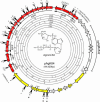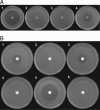Bases of biocontrol: sequence predicts synthesis and mode of action of agrocin 84, the Trojan horse antibiotic that controls crown gall
- PMID: 16731618
- PMCID: PMC1482666
- DOI: 10.1073/pnas.0602965103
Bases of biocontrol: sequence predicts synthesis and mode of action of agrocin 84, the Trojan horse antibiotic that controls crown gall
Abstract
Agrobacterium radiobacter K84, used worldwide to biocontrol crown gall disease caused by Agrobacterium tumefaciens, produces an antiagrobacterial compound called agrocin 84. We report the nucleotide sequence of pAgK84, a 44.42-kb plasmid coding for production of this disubstituted adenine nucleotide antibiotic. pAgK84 encodes 36 ORFs, 17 of which (agn) code for synthesis of or immunity to agrocin 84. Two genes, agnB2 and agnA, encode aminoacyl tRNA synthetase homologues. We have shown that the toxic moiety of agrocin 84 inhibits cellular leucyl-tRNA synthetases and AgnB2, which confers immunity to the antibiotic, is a resistant form of this enzyme. AgnA, a truncated homologue of asparaginyl tRNA synthetase could catalyze the phosphoramidate bond between a precursor of the methyl pentanamide side group and the nucleotide. We propose previously undescribed chemistry, catalyzed by AgnB1, to generate the precursor necessary for this phosphoramidate linkage. AgnC7 is related to ribonucleotide reductases and could generate the 3'-deoxyarabinose moiety of the nucleoside. Bioinformatics suggest that agnC3, agnC4, and agnC6 contribute to maturation of the methyl pentanamide, whereas agnC2 may produce the glucofuranose side group bound to the adenine ring. AgnG is related to bacterial exporters. An agnG mutant accumulated agrocin 84 intracellularly but did not export the antibiotic. pAgK84 is transmissible and encodes genes for conjugative DNA processing but lacks a type IV secretion system, suggesting that pAgK84 transfers by mobilization. By sequence analysis, the deletion engineered into pAgK1026 removed the oriT and essential tra genes, confirming the enhanced environmental safety of this modified form of pAgK84.
Conflict of interest statement
Conflict of interest statement: No conflicts declared.
Figures




Similar articles
-
Deletion derivatives of pAgK84 and their use in the analysis of Agrobacterium plasmid functions.Plasmid. 1992 Nov;28(3):201-12. doi: 10.1016/0147-619x(92)90052-c. Plasmid. 1992. PMID: 1461939
-
The S-adenosyl-L-homocysteine hydrolase gene ahcY of Agrobacterium radiobacter K84 is required for optimal growth, antibiotic production, and biocontrol of crown gall disease.Mol Plant Microbe Interact. 2009 Jun;22(6):713-24. doi: 10.1094/MPMI-22-6-0713. Mol Plant Microbe Interact. 2009. PMID: 19445596
-
Major biocontrol of plant tumors targets tRNA synthetase.Science. 2005 Sep 2;309(5740):1533. doi: 10.1126/science.1116841. Science. 2005. PMID: 16141066
-
Use of Agrobacterium radiobacter in agricultural ecosystems.Microbiol Sci. 1988 Mar;5(3):92-5. Microbiol Sci. 1988. PMID: 3079224 Review.
-
Agrocins and the biological control of crown gall.Microbiol Sci. 1984 Apr;1(1):1-4. Microbiol Sci. 1984. PMID: 6444087 Review.
Cited by
-
Bioinoculants-Natural Biological Resources for Sustainable Plant Production.Microorganisms. 2021 Dec 27;10(1):51. doi: 10.3390/microorganisms10010051. Microorganisms. 2021. PMID: 35056500 Free PMC article. Review.
-
Resource and competitive dynamics shape the benefits of public goods cooperation in a plant pathogen.Evolution. 2012 Jun;66(6):1953-65. doi: 10.1111/j.1558-5646.2011.01571.x. Epub 2012 Feb 14. Evolution. 2012. PMID: 22671559 Free PMC article.
-
Microbial population and community dynamics on plant roots and their feedbacks on plant communities.Annu Rev Microbiol. 2012;66:265-83. doi: 10.1146/annurev-micro-092611-150107. Epub 2012 Jun 20. Annu Rev Microbiol. 2012. PMID: 22726216 Free PMC article. Review.
-
Characterization of two seryl-tRNA synthetases in albomycin-producing Streptomyces sp. strain ATCC 700974.Antimicrob Agents Chemother. 2009 Nov;53(11):4619-27. doi: 10.1128/AAC.00782-09. Epub 2009 Aug 31. Antimicrob Agents Chemother. 2009. PMID: 19721072 Free PMC article.
-
Emerging Applications of Bacteriocins as Antimicrobials, Anticancer Drugs, and Modulators of The Gastrointestinal Microbiota.Pol J Microbiol. 2021 Jun;70(2):143-159. doi: 10.33073/pjm-2021-020. Epub 2021 Jun 21. Pol J Microbiol. 2021. PMID: 34349808 Free PMC article. Review.
References
-
- Roberts W. P., Tate M. E., Kerr A. Nature. 1977;265:379–381. - PubMed
-
- Tate M. E., Murphy P. J., Roberts W. P., Kerr A. Nature. 1979;280:697–699. - PubMed
-
- Murphy P. J., Tate M. E., Kerr A. Eur. J. Biochem. 1981;11:539–543. - PubMed
-
- Gelvin S. B. Ann. Rev. Plant Physiol. Plant Mol. Biol. 2000;51:223–256. - PubMed
-
- Ellis J. G., Murphy P. J. Mol. Gen. Genet. 1981;181:36–43.
Publication types
MeSH terms
Substances
Associated data
- Actions
- Actions
Grants and funding
LinkOut - more resources
Full Text Sources
Other Literature Sources
Medical

